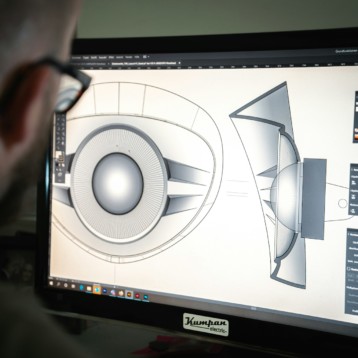With the continual release in recent years of new types of computer memory (RAM, ROM, DRAM, Flash, SRAM, PRAM…), the memory chip industry has become an ever more bewildering world. Freescale’s MRAM, one of the latest to be commercially unveiled, improves on and combines the advantages of two types of conventional memory.
|
The various types of computer memory can be classified in several different ways, the simplest of which is the division into volatile and non-volatile memory. Volatile memory requires constant power to maintain stored information. Most types of RAM (random access memory), the most common type of memory used by modern computers, are volatile. Thus, to store information, conventional RAM computer chips are dependent upon electricity flowing through them. When the power is switched off (i.e., when the system is “powered down”), unless the information has been copied to the hard drive, the information is lost.
Non-volatile memory, on the other hand, can retain stored information permanently, absolving the need for a constant power supply. ROM (read-only memory), which stores information that does not require frequent changing (i.e., doesn’t need rewriting), such as Firmware (a software embedded inside a hardware such as a BIOS [basic input-output system]), is typically non-volatile. So, even when the system is off, the data is stored.
Modern types of ROM such as Flash, used in thumb drives and many MP3 players, are also non-volatile, but easily rewritable, making them more like RAM. This combination of qualities has made Flash memory highly popular in recent years and it is currently used to improve other types of storage such as hard drives or even replace them altogether. But although Flash is cheap and non-volatile, it still suffers from a relatively limited lifetime. Though this had improved considerably in the last few years, more importantly, Flash still has a much lower write speed than RAM.
In an attempt to combine the speed of the faster volatile memory with the benefits of non-volatile memory, Freescale (which originated from Motorola Semiconductor about two years ago) created a new type of non-volatile memory – Magnetoresistive Random Access Memory, or MRAM. The roots of MRAM can be traced back to the 1940’s at Harvard when physicists An Wang and Way-Dong Woo and later Jay Forrester and colleagues at MIT worked on developments that led to Magnetic Core Memory and later on to the discovery of the “giant magnetoresistive effect” in thin-film structures by researchers from IBM in the late 1980’s. Like Flash, MRAM retains data after a power supply is cut off, potentially eliminating that seemingly endless boot time of conventional computers when data from the hard drive is transferred to RAM, as well as loss of data when the computer is suddenly shut off. MRAM has much faster write speeds than Flash and has an unlimited endurance, meaning that MRAM is not subject to the degradation suffered by Flash.
Conventional RAM memory is made of transistors and capacitors that are paired to create a memory cell, which represents one bit of data (0 or 1). Memory cells are aligned in columns and rows, the intersections of which are known as addresses in which information is stored. Reading and writing information occurs by measuring or changing the charge at a specific address, accordingly.
|
MRAM works in a different way, more like the read/write head of a hard drive. But unlike a hard drive, which includes mechanical parts (the moving arm holding the read/write head and the rotating plates on which the information is stored), MRAM is a solid state device and, as such, has much greater speed and durability. Like conventional RAM, MRAM is composed of transistors but, instead of electrical charges, it uses magnetic charges to store information. An MRAM chip is made up of millions of pairs of tiny ferromagnetic plates (like the one covering hard drives) called memory cells, i.e., magnetic sandwiches consisting of two magnetic layers separated by a very thin insulating layer. Each magnetic layer has a polarity – a north pole and a south pole. These can be oriented in a parallel orientation, meaning that both have their respective poles (or ‘magnetic moments’) in the same orientation, or in an anti-parallel fashion, meaning that their poles/magnetic moments are oriented in opposite directions. These relative magnetic pole orientations correspond to the binary memory states, either 0 or 1.
|
An MRAM chip reads information by measuring the electrical resistance of a specific cell that, in turn, depends upon the alignment of the magnetic moments of the layers of the cell. To read a bit of information, a current is passed through the memory cell. If the magnetic moments are in a parallel orientation, then the detected resistance would be smaller than if they were in an anti-parallel orientation.
Write is achieved by the alignment of the magnetic moments of the two memory layers into one or the other relative orientation. Current is passed through two sets of parallel wires or write lines (called a bit line and a digit or word line), which pass over and beneath the memory cells, respectively.The bit lines and the digit lines run perpendicular to one another and at their intersections lie the magnetic memory cells, each defined by one particular bit line and one particular digit line. To write to a particular memory cell (bit), current is passed through the two wires that intersect at that memory cell. The magnetic field that is generated from current passing through a wire can change the orientation of the magnetic moments of the particular memory cell.
Although MRAM has many advantages over virtually every existing memory type, it is still in its infancy. Many had hoped MRAM would usher in the age of instant-on computers able to replace the computer main memory and hard drives, but, due mainly to its cost, these hopes remain a dream. At $25 per 0.5 MB, MRAM has no chance of competing with existing RAM selling for $25 per 256 MB, not to mention Flash, which sells for $25 per 1 GB. The only place where MRAM might be widely utilized is in specialized markets, for example, as a Battery-Backed SRAM replacement. Only when it breaks its current high price per MB ratio (possibly with more advanced lithographic technology than its current 0.18 microns) will MRAM’s unique qualities find widespread usage.
Freescale interview
To learn more about Freescale’s new type of memory, TFOT interviewed John Salter, Freescale’s MRAM Product Development Manager.
Q: Would you expand on the history and development of MRAM, both in general and at Freescale in particular?
A: The story began in the 1990’s when Motorola Semiconductor Products Sector (from which Freescale spun out in 2004) generated, fabricated, and produced a 1 Mb MRAM device in a leaded package. Two years later, the organization patented its MRAM technology and manufactured a 4 Mb MRAM array. When Freescale struck out on its own in 2004, R&D on MRAM continued. Today, Freescale is the only company to have successfully overcome the hurdles involved with commercializing the technology.
Q: How does MRAM work and how does it differ from SDRAM and Flash memory?
|
A: Magnetoresistive Random Access Memory (MRAM) combines a magnetic device with standard silicon-based microelectronics to obtain the combined attributes of non-volatility, high-speed operation, and unlimited read and write endurance not found in any other existing memory technology. Each memory element uses a magnetic tunnel junction (MTJ) device for data storage. The tunnel junctions operate somewhat like transistors. Data is read as the resistance of these junctions. Using a magnetic state for storage has two main benefits: 1) the magnetic polarization does not leak away with time like charge does, so the information is stored even when the power is turned off; and 2) switching the magnetic polarization between the two states does not involve actual movement of electrons or atoms and thus has no known wear-out mechanism. The magnetoresistive device used in MRAM is very similar to the device used for the reader in hard disk drives.
The MTJ is composed of a fixed magnetic layer, a thin dielectric tunnel barrier, and a free magnetic layer. When an electrical bias is applied to the MTJ, electrons that are spin-polarized by the magnetic layers traverse the dielectric barrier through a process known as tunneling. The MTJ device has a low resistance when the magnetic moment of the free layer is parallel to the fixed layer, and a high resistance when the free layer moment is oriented anti-parallel to the fixed layer moment. This change in resistance with the magnetic state of the device is an effect known as magnetoresistance, hence the name “Magnetoresistive” RAM. During the write operation, current pulses are passed through a digit line and a bit line. The currents generate a magnetic field that writes only the bit in the array that is at the cross point of those two lines. The “1” or “0” is stored by putting the free layer magnetic moment into the antiparallel or parallel state, and the data is read by passing a current through the device to determine if the resistance is high or low.
Q: What is the target market for your current MRAM products (given a price of $25 for 0.5 MB)?
Q: What is the speed of your current MRAM and what is its latency?
A: The current speed of the MR2A16A device is 57 MB/s. This is a fully random access mode and, therefore, has no latency. Synchronization techniques could be added to the design to improve performance at the expense of latency and read/write complexity.
|
Q: What are Freescale’s plans for MRAM over the next five years?
A: Freescale has no plans to compete in the High Density commodity memory market. It is possible that expansion into some SRAM and Flash markets will be possible in the future, especially as embedded memory in our microcontrollers.















